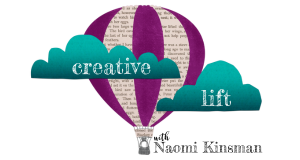 Every year, the Litquake staff put together a special event to serve students in San Francisco during their literary celebration. This event, Kidquake, provides an assembly where kids meet and learn from authors such as Jim Averbeck (In a Blue Room, One Word From Sophia). Also, a few classrooms are chosen by lottery to attend a writing workshop. And for the past two years, I’ve had the honor of providing one of these workshops, using Writerly Play.
Every year, the Litquake staff put together a special event to serve students in San Francisco during their literary celebration. This event, Kidquake, provides an assembly where kids meet and learn from authors such as Jim Averbeck (In a Blue Room, One Word From Sophia). Also, a few classrooms are chosen by lottery to attend a writing workshop. And for the past two years, I’ve had the honor of providing one of these workshops, using Writerly Play.Now, I know play works. I see it work every day in my classrooms—helping kids move from stuck to story.
So, why am I always surprised after a sequence of games, when each and every student hurries to his or her seat to pour ideas onto the page?
If ever there was a moment that Writerly Play wouldn’t work, it would be at Kidquake. The kids are out of their school environment, on a field trip, and meeting me for the very first time. I don’t know their unique quirks and I only have one hour to create a meaningful experience. They may expect to have fun, but they’re also guessing the workshop will be stressful—they’re going to have to write. They are usually young, in first, second or third grade. Even though their teachers prep them for good behavior, the odds of true focus are pretty low. And then, in these circumstances, I ask them to “stand up, push in their chairs and imagine with me.”
I have to admit … I was worried. But, then, as I witnessed their grand success, I was reminded of some key of the reasons play works.
1. Play is efficient
While teaching a Writerly Play workshop, I facilitate the physical movement activities with a series of questions. I could, instead, ask similar questions and discuss the various students’ ideas while all the rest listen. Even though kids do learn from listening to examples from their peers, if the immediate reaction to the question is application—movement—to show the first idea that comes to each of their minds, they all engage simultaneously. Then, as the questions help them deepen their surface ideas into more layered concepts, they continue to learn while playing. Play bypasses resistance, and students learn without having to wrestle through their fears, frustrations or perfectionism.
2. Play creates an atmosphere of suspense
During a game, kids don’t know what’s coming. Ask any marketer, author or screenwriter and they’ll tell you. Suspense is one of the best ways to keep an audience with you. Writerly Play engages learners in an experience filled with an absorbing question: What story might be hidden–like buried treasure–in my mind? With each answer, more of the treasure is revealed, and writers are compelled to keep digging until they find the full picture.
3. Play leads to discovery
Our brains are busy focusing on playing the game, and while we’re distracted, ideas spring to mind. Nearly everyone has had the experience of being asked a simple question, and not being able to come up with the answer. Being put on the spot is one of the most sure ways to shut the human brain down. So, it makes sense that presenting the invitation to create in a fun and nonthreatening way would lead to better results. Rather than panicking at the blank page, writers can let go of their inner critics and their need to know every detail as they play. We can’t know how the story will turn out as we start, and that’s frightening. We need a process that allows us not to know as we develop the idea past its fragile beginning into something that feels more solid and steady.
I learn something every time I play. The higher the stakes, the more I learn. Even though I was anxious about how the class would go, in the end, when the students arrived, I let go of all my worried thinking and threw myself into the game. In fact, I allowed myself to truly play too. To model the map-drawing activity that the students would do, I drew my own large-format map using their input. They threw out all kinds of ideas. Some were simple to draw. Others, like the dog or the dog-bone bush weren’t so simple. I felt myself hesitate. I don’t know how to draw a realistic dog. Rather than stalling out, I just drew the first shape that came out–which in my own defense, did have rather dog-like ears. We laughed over it together, and when it was the kids’ turn to draw, I noticed they didn’t hesitate either, even when they didn’t know how to draw whatever they were about to create.
Play allows us to do what would otherwise feel beyond us–which makes it a powerful tool. What about you? Has play allowed you to do something beyond your own skill set? Share in the comment section below, or on my Facebook page. I’d love to hear your stories.

